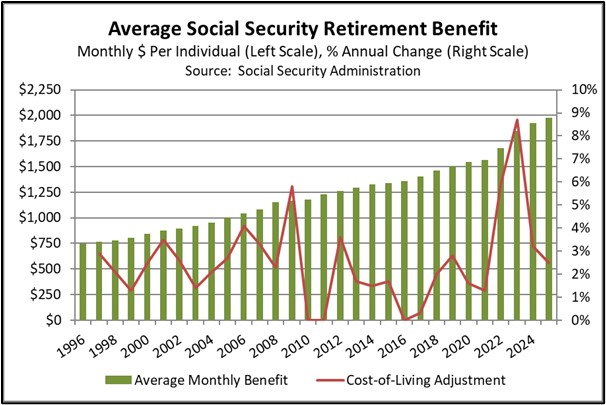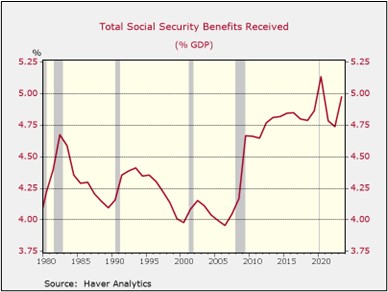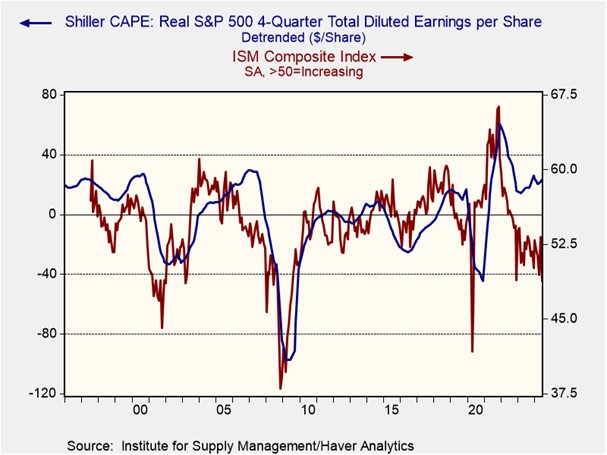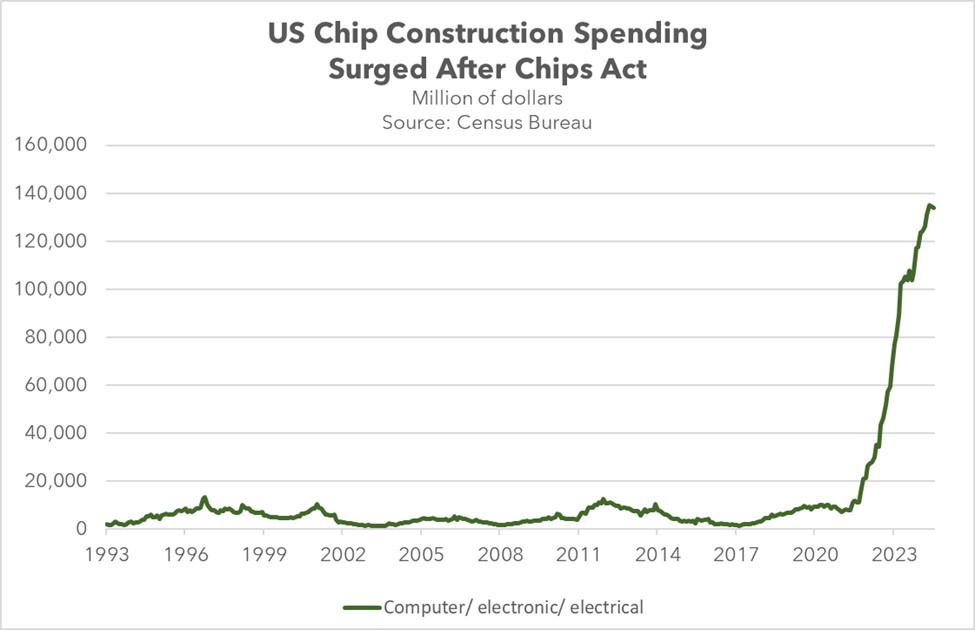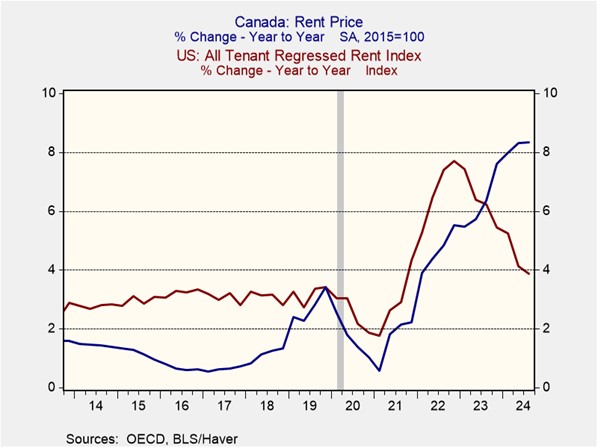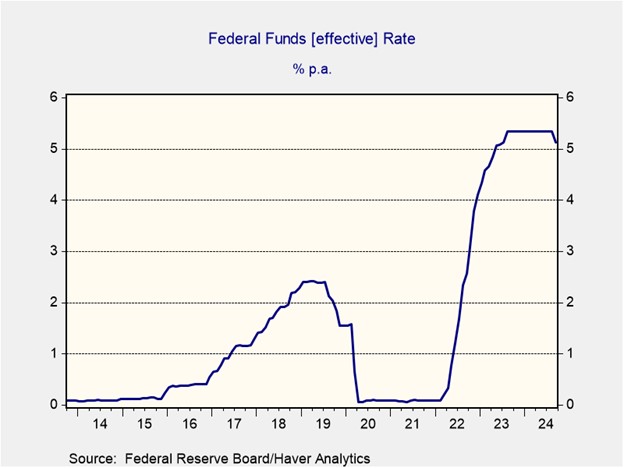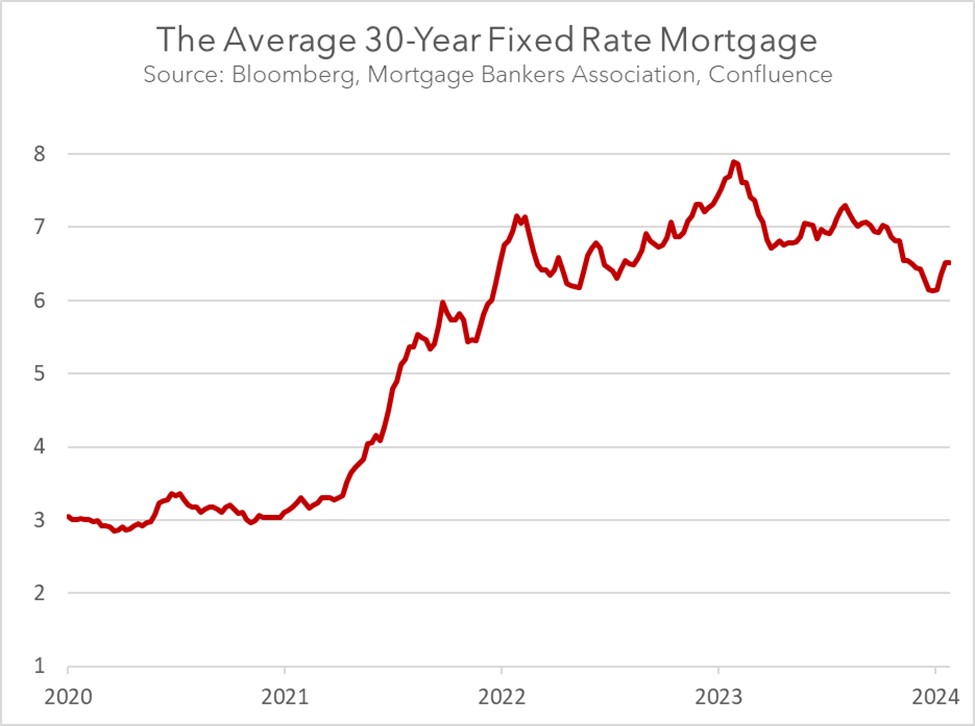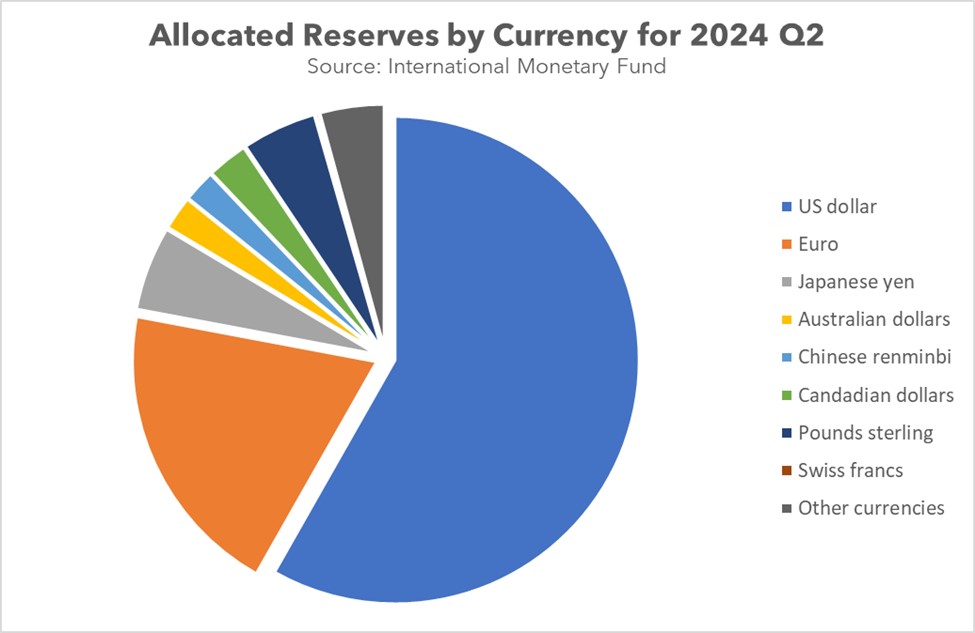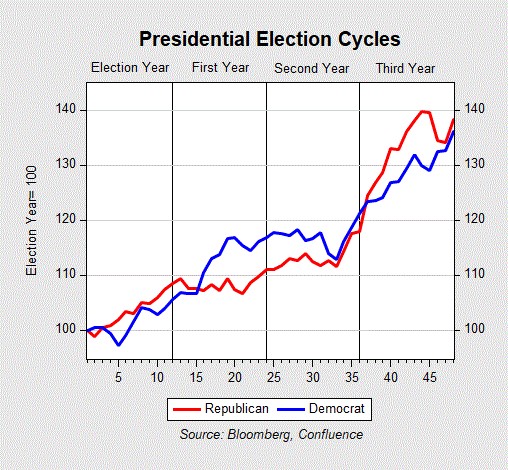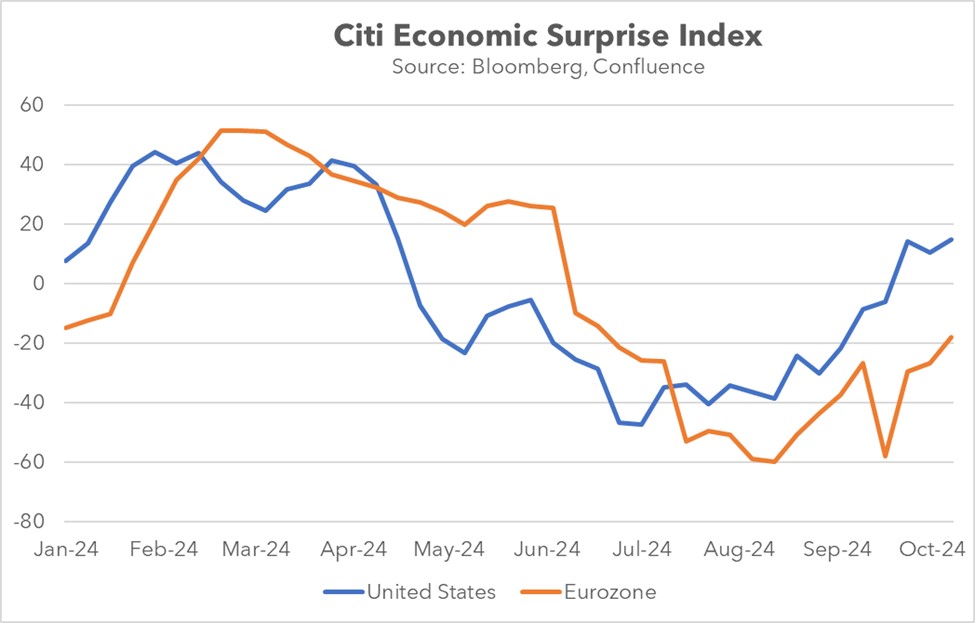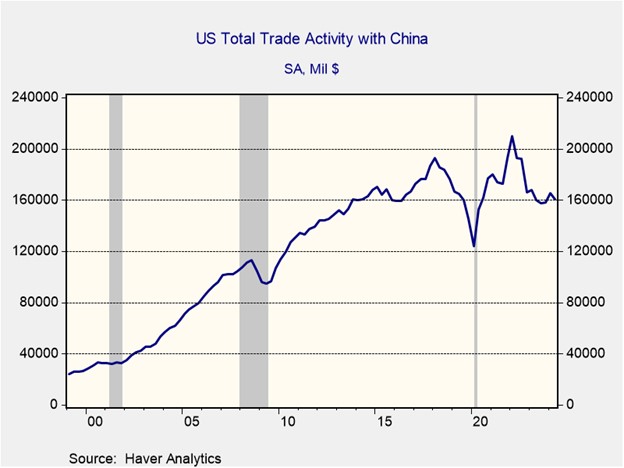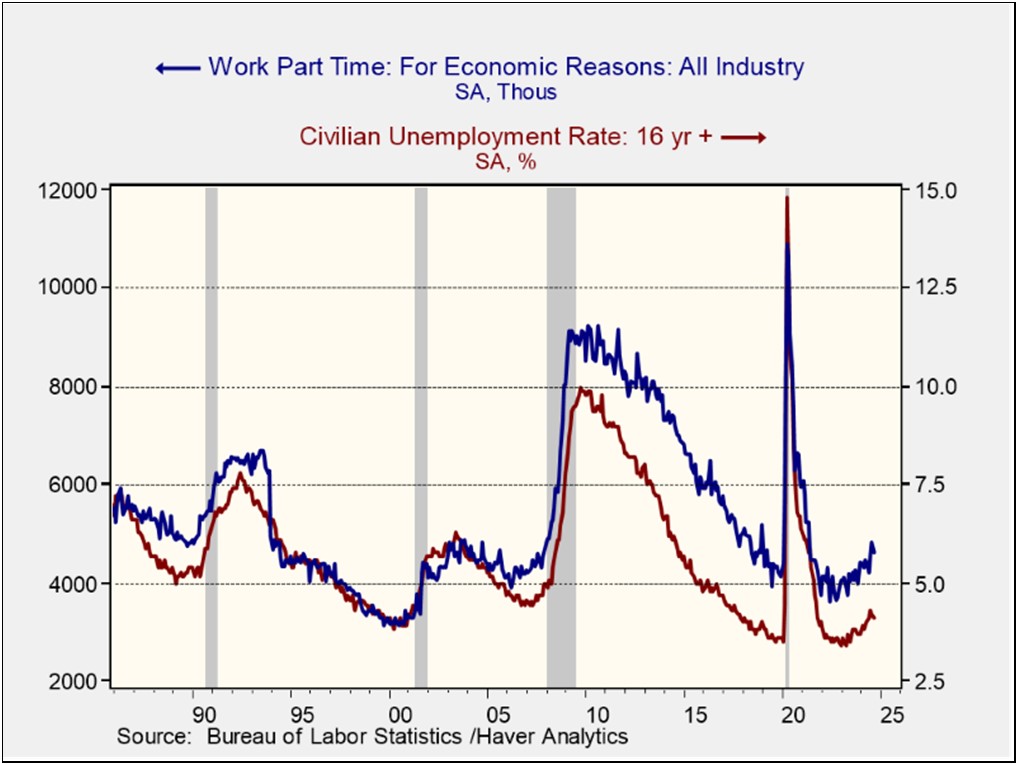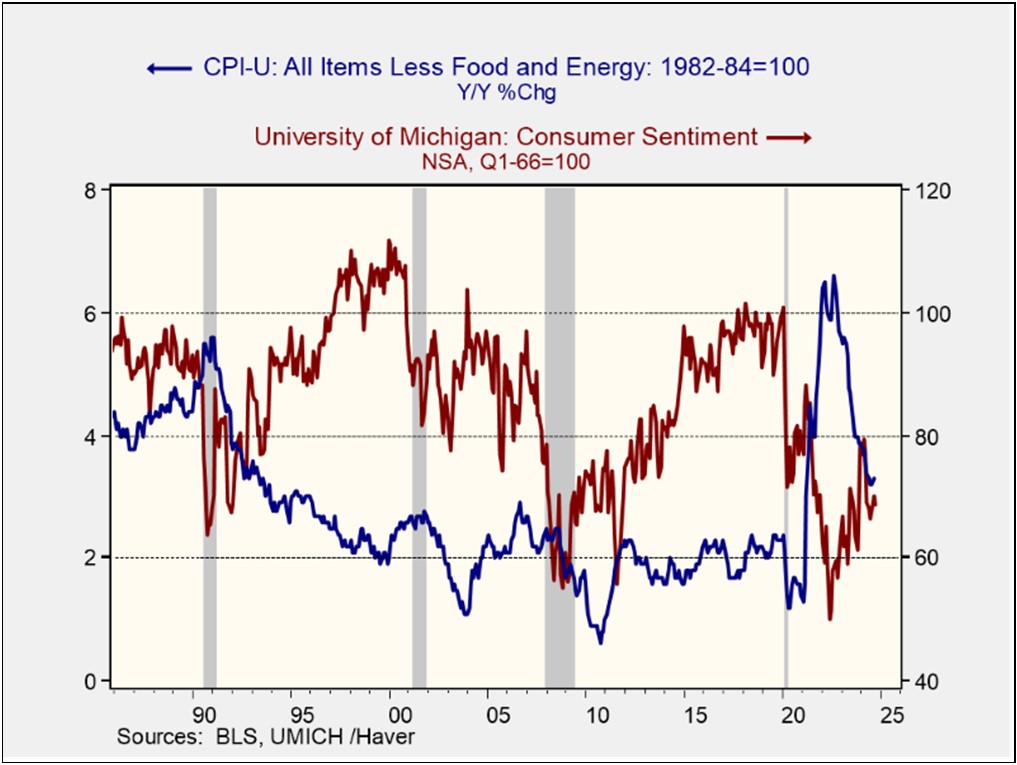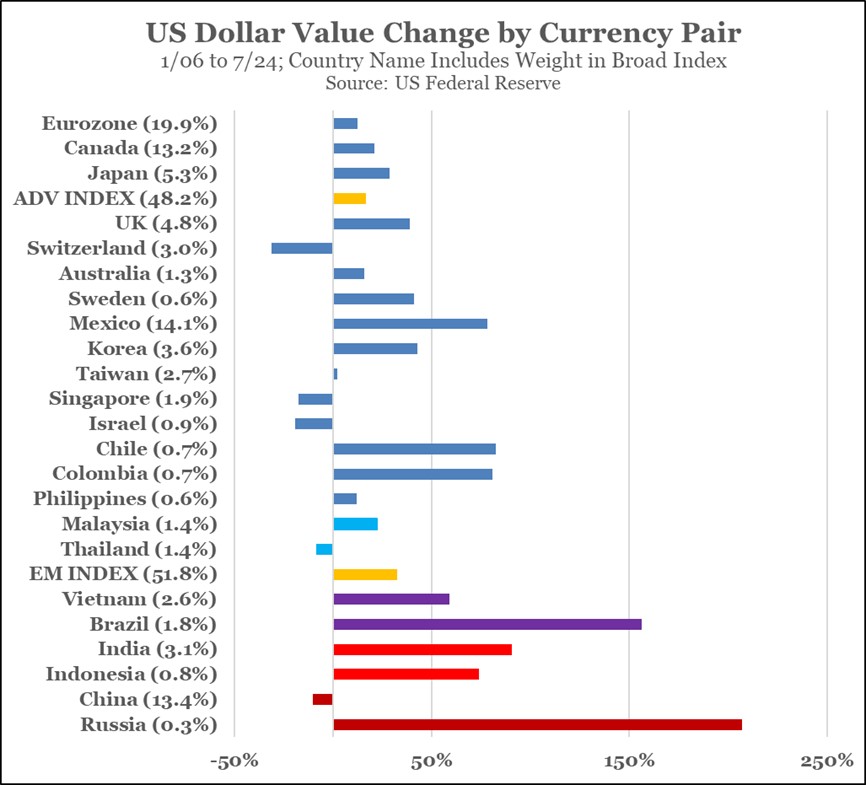Author: Amanda Ahne
Asset Allocation Bi-Weekly – The Inflation Adjustment for Social Security Benefits in 2025 (October 28, 2024)
by the Asset Allocation Committee | PDF
Even for dedicated, successful investors who have built up a substantial nest egg, Social Security retirement and disability investments can be an important part of their financial security. For many Americans, Social Security benefits may be the only significant source of income in advanced age. On average, Social Security benefits account for approximately 30% of elderly people’s income and more than 5% of all personal income in the US. There is one aspect of Social Security that is especially important in the current period of higher price inflation: By law, Social Security benefits are adjusted annually to account for changes in the cost of living. In this report, we discuss the Social Security cost-of-living adjustment (COLA) for 2025 and what it implies for the economy.
In mid-October, the Social Security Administration announced that Social Security retirement and disability benefits will increase 2.5% in 2025, bringing the average retirement benefit to an estimated $1,976 per month (see chart below). The increase, much smaller than those during the last couple years of high inflation, will bump up the average recipient’s monthly benefit by approximately $49. The benefit increase was right in line with expectations, given that it is computed from a special version of the Consumer Price Index (CPI) that is widely available. The COLA process also affected some other aspects of Social Security, although not necessarily by the same 2.5% rate. For example, the maximum amount of earnings subject to the Social Security tax was raised to $176,100, up 4.4% from the maximum of $168,600 in 2024.
Media commentators often fret that the Social Security COLA could be “eaten up” by rising prices in the following year, or that the benefit boost could provide a windfall if price increases decelerate. In truth, COLA merely aims to compensate beneficiaries for price increases over the past year. It is designed to maintain the purchasing power of a recipient’s benefits given past price changes with price changes in the coming year being reflected in next year’s COLA.
For the overall economy, the inflation-adjusted nature of Social Security benefits is particularly important. Since so many members of the huge baby boomer generation have now retired, and since more and more people are drawing disability benefits than in the past, Social Security income has become a bigger part of the economy (see chart below). In 2023, Social Security retirement and disability benefits accounted for 4.9% of the US gross domestic product (GDP). Having such a large part of the economy subject to automatic cost-of-living adjustments helps ensure that a big part of demand is insulated from the ravages of inflation, albeit with some lag. In contrast, if Social Security income were fixed, a large part of the population would be seeing its purchasing power drop sharply, which might not only reduce demand, but could also spark political instability. Of course, the additional benefits in 2025 will help buoy demand and keep inflation somewhat higher than it otherwise would be.
Finally, it’s important to remember that an individual’s own Social Security retirement benefit isn’t just determined by inflation. The formula for computing an individual’s starting benefit is driven in part by a person’s wage and salary history. Higher compensation will boost a retiree’s initial retirement benefit, which will then be adjusted via the COLA process over time. As average worker productivity increases, average wages and salaries have tended to grow faster than inflation, and as a result, the average Social Security benefit has grown much faster than the CPI. Over the last two decades, the average Social Security retirement benefit has grown at an average annual rate of 3.5%, while the CPI has risen at an average rate of just 2.6%. In sum, Social Security benefits provide an important source of growing purchasing power that helps buoy demand and corporate profits in the economy.
On the bottom line in our view, this year’s COLA announcement will prove to be market neutral. Although recipients may experience initial disappointment with this adjustment relative to those of recent years, the adjustment is actually more in line with those that came before the recent period of heightened inflation.
Daily Comment (October 25, 2024)
by Patrick Fearon-Hernandez, CFA, and Thomas Wash
[Posted: 9:30 AM ET] | PDF
Good morning! The market is eagerly awaiting the latest University of Michigan survey data to assess consumer sentiment ahead of the election. In sports news, the New York Yankees are set to take on the Los Angeles Dodgers in the first game of the World Series. Today’s Comment will explore what the strong October Purchasing Managers’ Index (PMI) indicates about corporate earnings. Next, we will provide an update on US chip production, followed by a discussion of Canada’s new immigration policy. As usual, our report will conclude with a roundup of international and domestic data releases.
US Shows Resilience: The latest S&P Global survey suggests that the economy is off to a robust start this quarter, indicating the potential for stable earnings growth.
- The October flash index showed an increase in business activity, with the composite PMI rising from 54.0 to 54.3. The services sector remained a key driver of the economy, while manufacturing continued to lag. Notably, firms raised prices for goods and services at the slowest pace in nearly 4.5 years. However, the employment component pointed to a slowdown in hiring for the third consecutive month. Despite weakness in exports, firms saw a sharp increase in new business, driven largely by strong domestic demand.
- The strong PMI data is a positive indicator for S&P earnings. As the accompanying chart demonstrates, a correlation exists between rising PMI values and improving corporate profitability. This relationship is likely due to the survey’s comprehensive tracking of key business metrics, including new orders, input and output prices, inventory levels, and overall business activity, which provides a valuable snapshot of the operational health of firms. As a result, the PMI has often been a good indicator when tracking the momentum of future corporate earnings.
- While the sideways movement in the index suggests that the economy is solidly in expansion, it also signals that significant earnings growth is unlikely in the near term. Nonetheless, this environment favors high-quality stocks with strong profitability and low debt levels, as they are better positioned to deliver sustainable dividends to investors. However, as confidence in a soft landing strengthens and the Fed begins to lower interest rates, we anticipate investors becoming more willing to take on risk.
US Chip Power: Taiwan Semiconductor Manufacturing Co (TSMC) has achieved a significant milestone at its US-based facility, bringing the United States one step closer to domestic chip manufacturing capabilities.
- TSMC’s Arizona plant has surpassed expectations, achieving production yields 4% higher than comparable facilities in Taiwan. This achievement, accomplished despite overcoming challenges such as labor disputes and construction delays, is a promising sign for US semiconductor independence. As the primary chip provider for Nvidia and Apple, TSMC’s increased domestic production capacity strengthens the company’s case for further government support under the CHIPS and Science Act. The company is expected to receive $6.6 billion in grants under this legislation.
- The expansion of semiconductor manufacturing hubs is at its most robust level in nearly half a century. Investments in facilities dedicated to computer, electronics, and electrical manufacturing now account for nearly 60% of total US construction spending, a significant increase from the approximately 8% share observed a decade ago. The new facilities are expected to triple the US’s chipmaking capacity by 2032, elevating its market share from 10% to 14% of global chip production. As a result, the US is better suited to be able to meet its growing demand for chips as it looks to dominate the AI space.
- The development of domestic semiconductor fabrication plants is likely to continue for national security reasons, but their long-term viability may be a concern if firms cannot significantly reduce costs. It has been widely speculated that firms may rely heavily on automation in these new facilities to maintain profitability. However, this could lead to pushback from lawmakers who want firms receiving funding to increase hiring for manufacturing workers. While we do not currently see this as a significant issue, it could become a potential problem in the future.
Canada Immigration Crackdown: Although the increase in foreign workers has bolstered the country’s economy, concerns over the rising costs of living have prompted a reassessment of immigration policy.
- On Thursday, the country released its Immigration Levels Plan, which aims to reduce the number of permanent residents by 20% by 2025. The new restrictions will cap the number of immigrants, leading to a contraction in the overall population over the next two years. Moderate growth is expected to resume in the third year. This policy change comes amid a growing backlash against the country’s immigration policies, which have allowed over 2.35 million people to immigrate since mid-2022, roughly the population of Houston.
- The surge in immigration has contributed to economic overheating, with rental inflation being a particular concern. Despite moderation in other areas and a decline in overall inflation, rental inflation has continued to accelerate, rising over 8% in Q3 2024 from the previous year. However, immigration has also helped boost Canada’s economic growth to match that of the US, at just over 2% per year over the past decade. As a result, there is an expectation that the restrictions could also slow the overall economy.
- The economic impact of immigration restrictions will depend largely on their effect on labor productivity. A significant increase in the labor supply can sometimes lead firms to become less inclined to adopt new technologies and improve their processes, which could potentially offset some of the production gaps caused by labor shortages. However, we believe that Canadian financial assets may benefit from the potential boost to consumer sentiment and spending resulting from these restrictions. Therefore, we maintain a cautiously optimistic outlook for the country.
In Other News: Cleveland Fed President Beth Hammack has reiterated that the central bank has more work to do before declaring victory over inflation, further indicating that many Fed officials favor a gradual approach to interest rate cuts. Meanwhile, new home sales increased in September as prospective buyers took advantage of the drop in mortgage rates. Russian President Vladimir Putin’s ambiguous explanation for the presence of North Korean troops in Russia suggests that he may be using the additional manpower to demonstrate his willingness to escalate the conflict in Ukraine.
Daily Comment (October 24, 2024)
by Patrick Fearon-Hernandez, CFA, and Thomas Wash
[Posted: 9:30 AM ET] | PDF
Good morning! The market is currently processing new earnings data. In sports news, Barcelona convincingly defeated Bayern Munich in the Champions League this week. Today’s Comment will begin with our analysis of the latest Federal Reserve Beige Book. We will then share our thoughts on the housing market and provide an overview of why Brazil finds itself caught in the middle of the conflict between the US and China. As always, the report will conclude with a roundup of economic and domestic data releases.
Fed’s Beige Book: The latest survey of business contacts in the Fed’s twelve districts indicates that economic growth has begun to slow.
- The latest Fed Beige Book supports the central bank’s recent decision to pivot, as contacts indicate a slowing economy. Nearly all Fed districts reported no change in economic activity since the previous September survey. Weakness was most evident in the manufacturing sector, with agriculture also showing signs of decline. In relation to the Fed’s dual mandate, over half of the firms reported slight to moderate hiring growth, while most noted a moderation in selling prices. That said, despite the dim outlook from business contacts, Fed officials remain positive.
- On Monday, Federal Reserve officials expressed optimism about the economy’s resilience, suggesting a cautious approach to interest rate cuts. While some favored a gradual reduction, others indicated that rate cuts could continue even in a strong economy. The latest dot plot reflects this divergence, showing a median expectation of 50 basis points in cuts for the rest of the year, but with nearly half of the committee favoring a more modest 25 basis point reduction. This varying degree of policy accommodation is likely to complicate the Fed’s efforts to coordinate monetary policy.
- While the Fed Beige Book may have emboldened dovish committee members, we believe the timing of the next rate cut hinges on the labor market’s strength and the level of inflation. The upcoming jobs report is projected to show 135,000 jobs added in October, with the unemployment rate remaining at 4.1%. Stronger-than-expected job growth or a falling unemployment rate could lead officials to skip a rate cut at their November meeting. Moreover, a 0.4% month-over-month increase in the core PCE price index, may necessitate a reassessment of the easing cycle altogether.
Residential Market: It has been over a month since the Fed cut rates, and the housing market has not rebounded.
- US sales of existing homes dropped to a 14-year low in September, with a 1.0% decline bringing sales to a seasonally adjusted annual rate of 3.84 million units. The subdued demand is likely tied to elevated home prices, despite borrowing costs reaching their lowest level in two years. The average home price is now roughly 6.3 times the average income, up from five times a decade ago. While lower borrowing costs have made homes more attractive, the main beneficiaries have been existing homeowners refinancing their mortgages to lower rates.
- Many potential homebuyers remain on the sidelines, waiting for mortgage rates to drop further and offset high home prices. This stems from the belief that rates will decline, mirroring their sharp rise during the Federal Reserve’s tightening cycle. In the first year of rate hikes, mortgage rates jumped from 3.5% to a peak of 7.2%, driven largely by uncertainty over how aggressively the Fed would raise rates. For rates to fall significantly, the Fed must clearly indicate how far it plans to cut interest rates. This is why rates have stopped their descent following the Fed’s first rate cut.
- The uncertainty surrounding the neutral interest rate (estimated to be between 2.25% and 4.00% according to the latest economic projections), complicates the outlook for mortgage rates. Inflation expectations, particularly the concerns about whether inflation will sustainably fall below 2%, play a significant role in determining the long-run path of Fed policy. As a result, mortgage rates are unlikely to decline significantly in the coming months, even if the central bank begins to cut rates. This could weigh on consumer sentiment and residential investment, hindering economic growth.
Brazil-China: Latin America’s largest economy appears to be under pressure to take sides in the US-China rift.
- On Wednesday, a US official urged Brazil to reconsider its plans to join China’s Belt and Road Initiative (BRI), cautioning that the agreement might not serve Brazil’s best interests as it could lead to a loss of sovereignty. This warning came in response to Brazil’s statements about potentially joining the initiative to counter protectionist measures from the US and the European Union. China remains one of Brazil’s top trading partners, while the US is one of the biggest contributors of foreign direct investment.
- The escalating dispute underscores growing concerns about the diminishing interconnectedness of the global economy. The West’s deliberate effort to reduce its role as the importer of last resort has prompted countries in the Global South to seek alternatives. Many are diversifying their currency reserves, including gold, and some are exploring regional currencies tied to their key commodities. This trend suggests that these countries are increasingly looking to offset the loss of trade with the West by trading with one another.
- As countries like Brazil navigate a less globalized world, we believe they will increasingly move away from using the US dollar. This shift is driven not only by the recent weaponization of the dollar but also by the desire to strengthen ties with other nations. In particular, countries aligned with China are likely to explore alternative currencies for trade as they reduce their reliance on the US. Although we don’t expect the dollar to lose its dominance, its influence may diminish over the next decade.
In Other News: The Bank of Canada cut its benchmark rate by 50 basis points, reflecting the global shift towards disinflation as it aims to normalize policy and shield Canada’s economy from further decline. Boeing workers voted against the latest wage agreement, likely setting the stage for an extended strike. Additionally, Tesla’s earnings report exceeded expectations, indicating that the worst may be over for the company.
Daily Comment (October 23, 2024)
by Patrick Fearon-Hernandez, CFA, and Thomas Wash
[Posted: 9:30 AM ET] | PDF
Good morning! The market is eagerly awaiting the latest wave of earnings reports. In sports news, Real Madrid staged a remarkable comeback and defeated Borussia Dortmund 5-2 with five unanswered second-half goals. Today’s Comment will explore the market’s anticipation of a Republican sweep in the upcoming election, analyze the economic indicators suggesting a more dovish ECB compared to the Federal Reserve, and delve into the ongoing reluctance of Western companies to sever ties with China despite escalating tensions. As always, the report will include a summary of key domestic and international economic data releases.
Red Wave is Coming? Election jitters are starting to make their way into the market as investors grow bullish about a potential Republican sweep in November.
- Though the election remains a toss-up, markets seem to be preparing for a potential Republican victory. The 10-year Treasury yield has been the most noticeably hit by concerns over higher inflation expectations driven by tariffs and rising deficits, triggering some selloffs. Meanwhile, the Mexican peso (MXN) has plunged amid fears that a new government could strain relations over trade, border security, and recent judicial reforms. The movement is likely a reflection of investors not wanting to hold on to certain assets until there is certainty regarding the outcome.
- The greatest uncertainty stems from how a Republican-controlled government will act on campaign promises. President Trump’s tax proposals, including eliminating taxes on tips, lowering corporate taxes, and offering exemptions for military personnel, police, and firefighters, are expected to significantly increase the national deficit. There is also uncertainty surrounding tariffs, which have ranged from 10% on all imports to as high as 2000% on specific Chinese goods. Moreover, doubts persist about the seriousness of some of these proposals as there are concerns about their feasibility.
- The outcome of the congressional and presidential elections will likely depend on a few key votes, so investors should be cautious about assuming a clear winner and avoid being surprised by an unexpected result. The red wave optimism of 2022 serves as a reminder that polls can be unreliable. While we can anticipate some market volatility around election day, it is unlikely to significantly impact the long-term trends of Treasury yields or equity performance. Regardless of the outcome in November, the winning party is likely to scale back on campaign promises quickly.
Leading the Pack: While the eurozone’s growth remains uncertain, the US economy is beginning to gain traction.
- The United States was the only developed country to have its economic growth outlook upgraded by the International Monetary Fund for the next two years. According to the supranational agency, the US is expected to maintain its position as the driving force of global growth, fueled by consumer spending this year and next. In contrast, the eurozone’s growth outlook has been downgraded for the coming two years, weighed down primarily by a slowing in manufacturing, tightening of fiscal policy, and cooling of the labor market.
- Recent data suggests the ECB and Fed will ease at different rates. The US Citigroup Economic Surprise Index entered positive territory earlier this month, as economic data has consistently exceeded expectations. In contrast, the eurozone’s economic surprise data, while improving, remains negative. The more robust US performance has led Fed officials to advocate for a more gradual approach to rate cuts. Meanwhile, the continued weakness in the eurozone has prompted ECB officials to push for aggressive easing to prevent the region from slipping into recession.
- Despite differing outlooks, the IMF maintains that global inflation has largely been defeated. This suggests that central banks should continue their easing cycles in the coming months. We anticipate that the Fed will likely cut rates by at least 25 basis points before the year’s end, assuming there are no inflationary setbacks. Meanwhile, the European Central Bank could reduce rates by 50 basis points at its next meeting. The ECB’s relatively dovish stance and economic weakness should lead the euro (EUR) to depreciate against the dollar.
Middle Ground on China: Firms appear to be unwilling to readily give up ties with China even as the West continues to reduce ties with the second largest economy.
- Apple CEO Tim Cook has reaffirmed the company’s commitment to investing in China, highlighting the country’s crucial role in its supply chain. This statement follows a recent meeting with a top Chinese technology official to discuss strengthening bilateral ties as the Chinese economy has struggled to regain its footing following the pandemic. In the meeting, the Chinese officials pushed Cook to agree to invest in some of its key industries, such as cloud services and the secure management of data.
- Despite Beijing’s reassurances of its commitment to prevent a prolonged economic slowdown, foreign direct investment in China has declined. Investors remain concerned about the potential for deflation and increased Western scrutiny of Chinese exports. In recent years, China’s trade relationship with the United States has faced challenges as officials have raised import tariffs and tightened export restrictions on companies. As a result, trade activity between the US and China remains well below its long-term trend.
- Economic decoupling between the United States and China is likely to occur, despite potential resistance from some companies. While the transition may be slower than anticipated, the overall trend remains clear as both sides don’t trust one another. US companies with significant revenue or supply chain exposure to China are particularly vulnerable to the disruptions associated with this shift. Investors should consider adjusting their portfolios accordingly to mitigate these risks.
In Other News: The latest AI processors for Huawei Technologies were developed by TSMC, indicating that the company is circumventing some of the export restrictions imposed by the US. Additionally, US officials have confirmed that they believe Russia has used North Korean troops in its conflict with Ukraine. This decision exemplifies the growing threat posed by this new axis of evil. Lastly, Israel has confirmed the killing of a potential successor to Hezbollah, signaling that it is closer to achieving its objectives in Lebanon.
Asset Allocation Quarterly (Fourth Quarter 2024)
by the Asset Allocation Committee | PDF
- Our three-year forecast includes balanced economic growth, albeit at a slower pace than recent experience, and inflation settling above the Fed’s target rate.
- The Fed is expected to continue easing at a measured pace over the next year.
- We initiated a position in long-duration, zero-coupon Treasurys as a stabilizer amid potential global policy uncertainty and default risks.
- We continue to favor small and mid-cap domestic equities which offer appealing valuations and growth prospects relative to large caps.
- International developed equities remain in the portfolios, but we avoid emerging markets due to heightened risks.
- We preserve an allocation to gold as a hedge against geopolitical risks, with an allocation to silver where risk appropriate.
ECONOMIC VIEWPOINTS
Recent economic growth has been bolstered by a strong labor market, fiscal stimulus, and resilient personal consumption. We expect fiscal spending and continued strong labor markets to sustain growth during the beginning of the forecast period, both of which would support the consumer. While the overall business spending and personal consumption sentiment has been generally optimistic, momentum is slowing at the margin. The latest GDP report highlights that a part of the recent expansion stems from drivers that may be short-term in nature, such as inventory build-up ahead of a potential port strike. As we look ahead, we expect the labor market and consumption to be supported by easing monetary policy and lower inflation. The heightened uncertainty surrounding immigration policy could lead to a scenario where labor markets remain tight, which would continue to bolster household incomes. However, toward the end of the forecast period, consumption could moderate and potentially lead to increased uncertainty in the labor markets.
This first chart shows that while civilian unemployment, shown in red, has remained subdued at 4.1%, we are seeing some weakness with part-time work for economic reasons, shown in blue, ticking higher. Wage growth momentum has moderated but remains elevated compared to the pre-pandemic decade. It is worth noting that job openings have fallen as companies anticipate slower expansion, and a notable increase occurred in the long-term unemployed (27 weeks or more), which we anticipate will also be a drag on the labor markets.
While the Fed’s 50 bps rate cut and expectations for further easing support the expansion, high prices and relatively low rates of savings have made consumers more frugal. Such economic uncertainty has the potential to lead firms to delay investment and households to postpone buying big-ticket items, actions which we have already seen to a degree. Consumer sentiment, shown in red on the second chart, has improved since inflation, in blue, receded from its cyclical peak in 2022. We expect consumption to moderate as households have depleted their stimulus-driven savings and have grown more concerned about future job prospects.
Additionally, the favorable tax treatments for individuals in the Tax Cuts and Jobs Act of 2017 are due to sunset at the end of 2025. While each of the presidential candidates has shown support for extending at least some part of the tax act for individuals, tax policy cannot be unilaterally controlled by the president. To extend these tax cuts, both houses of Congress must pass legislation. While individual tax breaks are set to expire, most of the favorable corporate tax treatments, including the reduction of corporate tax rates from 35% to 21%, do not sunset.
The US presidential election will take place this quarter, and while highly publicized, these elections generally have a limited long-term impact on financial markets. However, given the current political climate, we are taking precautionary measures. We maintain a position in gold as a hedge and have increased our exposure to long-dated Treasurys to mitigate potential risks. Either candidate is expected to govern alongside a divided Congress, which reduces the likelihood of abrupt policy changes.
STOCK MARKET OUTLOOK
We expect corporate profit margins to remain healthy during the forecast period but we’re closely monitoring earnings quality for signs of potential weakness. With moderate economic growth and stable margins, we are maintaining an even-weight position in equity risk. The record level of cash on the sidelines continues to support valuations as we’ve seen these funds flow into risk assets during market pullbacks. This suggests that investors remain generally comfortable with equity exposure but are mindful of valuation levels. Furthermore, as the Fed continues to ease, lower money market rates may drive more capital into equities.
We are even-weight on the growth versus value style bias. While we recognize the concentration risk in a few prominent growth stocks, we believe current economic conditions will support equities across the board. We’re overweight mid-cap equities due to attractive valuations. While small cap stocks also offer appealing valuations, many small caps face higher sensitivity to debt refinancing. To manage risk and focus on earnings quality, we hold a small cap quality factor position, screening for profitability, leverage, and free cash flow.
We also maintain an overweight in the Energy sector and uranium miners, driven by Middle Eastern geopolitical tensions and the global energy transition. Our exposure to military hardware and cyber-defense remains a strategic portfolio component.
International developed equities remain attractive due to valuation discounts. Many global market leaders in the developed world ETFs are trading at lower valuations compared to US large caps. However, due to concerns about European economic growth, we have reduced developed market exposure in some portfolios. We maintain targeted exposure to Japan, where ongoing shareholder-friendly reforms and continued capital inflows may drive multiple expansion. We continue to exclude emerging market equities despite steep valuation discounts as we believe the risks surrounding Chinese growth outweigh the potential returns.
BOND MARKET OUTLOOK
Expectations for fixed income markets largely depend on inflation trends. While we expect volatility of inflation to remain elevated, the likelihood of a spike to levels experienced in 2022-2023 is slim. Rather, we expect inflation to decline gradually but unevenly from those highs, though we find it unlikely that the Fed will achieve its 2% target level within our three-year forecast period. While this became the target during the period of zero rates of the past decade, we find that a level around 3% is much more likely.
Against the backdrop of inflation expectations, the Fed’s data dependency heralds the prospect for three-month rates to remain relatively elevated compared to two-year rates. This implies that, absent a significant economic shock or a deep recession, the yield curve is more than a year away from returning to a normal, positive slope across all maturities. Accordingly, we find a mix of maturities to be the appropriate exposures in the strategies as the process unwinds. Within sectors, we are underweight investment-grade corporates due to their historical tight spreads. However, we are overweight mortgage-backed securities (MBS), where low refinancing activity has created attractive pricing. Contrasted with investment-grade corporates, speculative grade corporates maintain an attractive spread of nearly +300 basis points. Nevertheless, some caution encourages our preference for the higher BB-rated bonds in this asset class.
Although the majority of the bond exposure in the strategies is in the short to intermediate section of the curve, the combination of heightened geopolitical risk, uncertainty surrounding the US legislative and presidential election outcomes, and resulting potential policy changes leads to the introduction of a modest exposure to long-term, zero-coupon Treasurys in most strategies, the intention of which is to act as a hedge against these risks. A long-duration bond may serve as a ballast against market volatility due to its inverse relationship with interest rates and its role as a stabilizing asset in a diversified portfolio.
OTHER MARKETS
We continue to hold a position in gold across all portfolios. Despite gold spot prices reaching record highs this year, we believe additional Fed interest rate cuts and continued central bank purchases could push gold prices higher. The gold position also offers a strategic layer of protection against volatility, given its historical role as a safe-haven asset during periods of geopolitical instability. In portfolios with higher risk tolerance, silver is retained as a complementary precious metal holding. While REIT valuations have improved and the prospect of lower interest rates should generally benefit the sector, we have ongoing concerns around debt refinancing challenges and property valuations that lead us to avoid this sector this quarter.
Keller Quarterly (October 2024)
Letter to Investors | PDF
“Will it play in Peoria?” That wonderfully alliterative question originated in the show business community. A show that might “knock ‘em dead” in New York might not be so popular in the rest of the country. We live in a big nation. While there is a commonality that binds us together, there are meaningful cultural differences. New York, Philly, Boston, and Miami all have their unique qualities, as do Houston, Denver, San Francisco, and LA. As I travel the country I’ve come to admire and enjoy all these mini cultures.
I’m thinking about Peoria, Illinois, because I’ll be visiting that town soon. I’ve been travelling there regularly for about 25 years because of the many friends and clients I have there. What gave rise to the idea that if a show does well in Peoria it will do well anywhere? Like much of the Midwest, Peoria is a place of easy-going, but hard-working and friendly people; people who don’t mind being characterized by words like calmness, perseverance, and normal. In a country where so many people seem to be lined up on the extremes of anything, Peoria provides a delightful middle. It’s neither too high nor too low. If the Peorians like it, mainstream America will love it!
What’s the point of this paean to a Midwestern disposition? I think it is the ideal temperament for successful long-term investing, and you don’t have to be from the Midwest to develop it. It’s important not to let oneself get too excited about something great or get too depressed about a negative development. I believe keeping one’s emotions in check is the single most important thing an investor can do. Investing should be a rational, thoughtful endeavor.
I’ve written before that the same emotions that make us human can be the enemies of successful investing. Emotional extremes generally lead to irrational decisions. There may be many reasons to get emotional about this year’s election, but, in my opinion, the impact on your portfolio should not be one of them. Neither party seems particularly interested in reducing federal spending or substantially increasing the tax burden on the US economy. Thus, we expect federal deficits to remain large no matter which party controls the purse. Both parties are likely to continue tariffs on a variety of Chinese goods destined for the US. Whatever their differences on non-economic issues, we expect that these economic policies, which we believe are inflationary, will remain in place.
As I discussed at length in my last letter (July 2024), the factors that have made the US an extraordinarily good place to invest are still in place and not likely to be affected by the national election. The recent Confluence Asset Allocation Bi-Weekly from September 30, 2024, exhibited data since 1930 indicating that stock market returns have shown virtually no preference for which party was in power.
I repeat what I wrote last quarter, quoting my letter from October 2020: The stock market is neither Republican nor Democrat but is solely interested in making money. In my opinion, the current environment is well-suited to doing just that, regardless of who wins the election.
As we’ve said for several years, we expect inflation rates to remain above the average of the last decade for the foreseeable future. In our opinion, this should be the investor’s primary concern. Our investment strategies, be they domestic equities, international equities, or asset allocation portfolios, have this expectation in mind: that inflation is likely to remain higher than investors expect. The professionals at Confluence Investment Management have experience investing in rising inflation environments. It’s not unknown to us, like Peoria.
We appreciate your confidence in us.
Gratefully,
Mark A. Keller, CFA
CEO and Chief Investment Officer
Daily Comment (October 22, 2024)
by Patrick Fearon-Hernandez, CFA, and Thomas Wash
[Posted: 9:30 AM ET] | PDF
Our Comment today opens with a preview of the big BRICS summit of emerging-market nations such as China, Russia, and Iran. Since the group includes key countries in China’s geopolitical bloc, we’ll be looking to see how much General Secretary Xi dominates the meeting, despite it being hosted by Russian President Putin. We next review several other international and US developments that could affect the financial markets today, including an important new IPO on the Indian stock market and a court ruling that favors the US oil and gas industry.
BRICS Summit: A summit of the BRICS emerging-market countries kicks off today in Russia. While the group is led by Brazil, Russia, India, China, and South Africa (accounting for its acronym), this will be the first summit since the group was expanded to include Saudi Arabia, Iran, the United Arab Emirates, Egypt, and Ethiopia. Importantly, leading countries in the group say the summit will discuss further steps to reduce use of the US dollar in international trade and develop a BRICS currency and non-dollar international payments system.
- The discussions on moving further away from the dollar and Western systems will likely play into investor concerns about the greenback’s value going forward. That could weigh on the dollar and boost gold prices in the coming days.
- Nevertheless, as we noted in our Comment yesterday, the effort by some countries to cut their use of the dollar hasn’t stopped it from appreciating against most other major currencies for the last decade and a half. The chart below shows how the greenback’s value has changed against each currency in the Federal Reserve’s broad dollar index since roughly the beginning of its long bull market.
China: According to market data provider Wind, share buybacks by companies listed on China’s domestic stock exchanges have reached the equivalent of $33 billion for the year to date, almost double the record amount in all of 2022. The buybacks have been driven by a special lending facility that was part of last month’s economic stimulus program. If the strong buybacks continue, they could help buoy the market even as investors begin to question the efficacy of the overall stimulus program.
India: South Korean auto maker Hyundai Motors today raised the equivalent of $3.3 billion by listing 18% of its local unit on India’s main stock exchanges. Even though the share price fell modestly by day’s end, the rich IPO valuation for the unit is expected to entice other global companies to consider listing their Indian units as well. That prospect underscores India’s attractiveness as one of the world’s few large, fast-growing economies.
European Union: For the first time since Russia invaded Ukraine in 2022, leading to shortages of natural gas in the EU, we’ve noticed that media concerns about gas storage have fallen off sharply. Nevertheless, we think it’s important to note that EU gas storage is now more than 95% full, above the five-year average of around 92% for this time of year. That has kept a lid on EU gas prices and should help limit the damage if geopolitical events disrupt international supplies this winter.
United Kingdom: Bank of England Chief Economist Huw Pill has reportedly sent a private letter to the Office of National Statistics complaining that the agency still hasn’t fixed its problem with unreliable estimates regarding employment and other aspects of the labor market. The episode shows how statistics agencies, including in the US, have struggled with falling survey response rates, which have led to big data revisions and called into question the accuracy of economic data. (Of course, the same dynamic has rendered political polls less reliable.)
US Economic Policy: With exactly two weeks to go before the presidential election, we still consider the contest too close to call. Nevertheless, we’re intrigued by an article in today’s Financial Times that looks at the possible economic policies of Vice President Harris if she were to win. The article is useful because, as we noted in our recent Bi-Weekly Geopolitical Report comparing US foreign policy under Trump versus Harris, the vice president’s policy views are hard to read, based on her relatively low profile in the Biden administration and her own campaign strategy.
- The article claims Harris’s most likely picks for Treasury Secretary would be current Deputy Treasury Secretary Wally Adeyemo, current Commerce Secretary Gina Raimondo, or current White House Chief of Staff Jeff Zients.
- The article says Harris might also consider Federal Reserve board member Lael Brainard as Treasury secretary, but she may prefer to have her replace Jerome Powell as Fed chair when his term expires in 2026.
- The article also notes that Harris has much closer ties to top business leaders than President Biden does. The article therefore suggests Harris would listen more closely to business concerns about the economy and move away from some of Biden’s more progressive policies.
US Oil Industry: A federal judge yesterday ruled that a regulation friendly to the offshore oil industry should remain in place until next May, rather than expiring as scheduled in December. The regulation exempts the industry from a rule protecting a nearly extinct whale species, and industry lobbyists had argued that if the exemption expires, all US oil rigs in the Gulf of Mexico would have to shut down. Environmentalists have argued that the industry position amounts to fear mongering.
US Spirits Industry: According to industry data provider IWSR, the volume of alcoholic spirits sold in the US from January through July was down 3.0% from the same period one year earlier, accelerating from a 2.9% decline in full-year 2023 and a flat performance in 2022. For comparison, US spirits consumption had increased at an average annual rate of 2.6% per year in the two decades to 2019, and the growth rate nearly doubled in the pandemic years of 2020 and 2021. What’s unclear is whether the recent declines are structural or merely cyclical.



